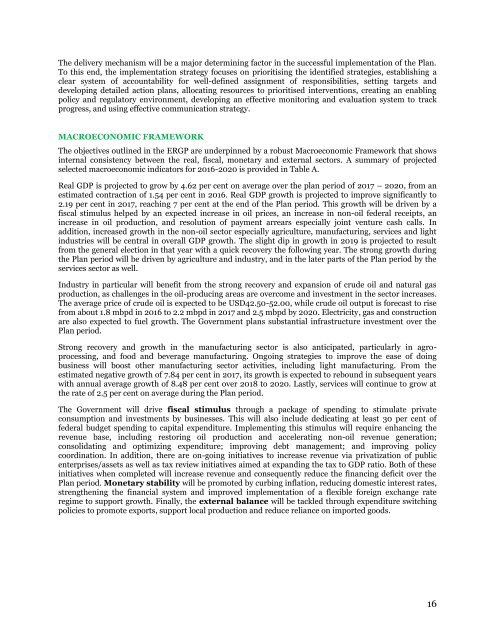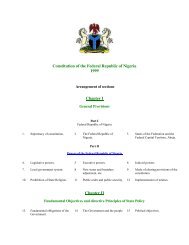Economic Recovery Growth Plan (ERGP) 2017-2020
This Medium Term Plan of the Federal Republic of Nigeria was designed to tackle the huge decline in the country’s economy since her shift from agriculture sector to crude oil and gas sector in the late 1960s. The plan’s objective includes restoring growth, investing in citizens and building a globally competitive economy.
This Medium Term Plan of the Federal Republic of Nigeria was designed to tackle the huge decline in the country’s economy since her shift from agriculture sector to crude oil and gas sector in the late 1960s. The plan’s objective includes restoring growth, investing in citizens and building a globally competitive economy.
You also want an ePaper? Increase the reach of your titles
YUMPU automatically turns print PDFs into web optimized ePapers that Google loves.
The delivery mechanism will be a major determining factor in the successful implementation of the <strong>Plan</strong>.<br />
To this end, the implementation strategy focuses on prioritising the identified strategies, establishing a<br />
clear system of accountability for well-defined assignment of responsibilities, setting targets and<br />
developing detailed action plans, allocating resources to prioritised interventions, creating an enabling<br />
policy and regulatory environment, developing an effective monitoring and evaluation system to track<br />
progress, and using effective communication strategy.<br />
MACROECONOMIC FRAMEWORK<br />
The objectives outlined in the <strong>ERGP</strong> are underpinned by a robust Macroeconomic Framework that shows<br />
internal consistency between the real, fiscal, monetary and external sectors. A summary of projected<br />
selected macroeconomic indicators for 2016-<strong>2020</strong> is provided in Table A.<br />
Real GDP is projected to grow by 4.62 per cent on average over the plan period of <strong>2017</strong> – <strong>2020</strong>, from an<br />
estimated contraction of 1.54 per cent in 2016. Real GDP growth is projected to improve significantly to<br />
2.19 per cent in <strong>2017</strong>, reaching 7 per cent at the end of the <strong>Plan</strong> period. This growth will be driven by a<br />
fiscal stimulus helped by an expected increase in oil prices, an increase in non-oil federal receipts, an<br />
increase in oil production, and resolution of payment arrears especially joint venture cash calls. In<br />
addition, increased growth in the non-oil sector especially agriculture, manufacturing, services and light<br />
industries will be central in overall GDP growth. The slight dip in growth in 2019 is projected to result<br />
from the general election in that year with a quick recovery the following year. The strong growth during<br />
the <strong>Plan</strong> period will be driven by agriculture and industry, and in the later parts of the <strong>Plan</strong> period by the<br />
services sector as well.<br />
Industry in particular will benefit from the strong recovery and expansion of crude oil and natural gas<br />
production, as challenges in the oil-producing areas are overcome and investment in the sector increases.<br />
The average price of crude oil is expected to be USD42.50-52.00, while crude oil output is forecast to rise<br />
from about 1.8 mbpd in 2016 to 2.2 mbpd in <strong>2017</strong> and 2.5 mbpd by <strong>2020</strong>. Electricity, gas and construction<br />
are also expected to fuel growth. The Government plans substantial infrastructure investment over the<br />
<strong>Plan</strong> period.<br />
Strong recovery and growth in the manufacturing sector is also anticipated, particularly in agroprocessing,<br />
and food and beverage manufacturing. Ongoing strategies to improve the ease of doing<br />
business will boost other manufacturing sector activities, including light manufacturing. From the<br />
estimated negative growth of 7.84 per cent in <strong>2017</strong>, its growth is expected to rebound in subsequent years<br />
with annual average growth of 8.48 per cent over 2018 to <strong>2020</strong>. Lastly, services will continue to grow at<br />
the rate of 2.5 per cent on average during the <strong>Plan</strong> period.<br />
The Government will drive fiscal stimulus through a package of spending to stimulate private<br />
consumption and investments by businesses. This will also include dedicating at least 30 per cent of<br />
federal budget spending to capital expenditure. Implementing this stimulus will require enhancing the<br />
revenue base, including restoring oil production and accelerating non-oil revenue generation;<br />
consolidating and optimizing expenditure; improving debt management; and improving policy<br />
coordination. In addition, there are on-going initiatives to increase revenue via privatization of public<br />
enterprises/assets as well as tax review initiatives aimed at expanding the tax to GDP ratio. Both of these<br />
initiatives when completed will increase revenue and consequently reduce the financing deficit over the<br />
<strong>Plan</strong> period. Monetary stability will be promoted by curbing inflation, reducing domestic interest rates,<br />
strengthening the financial system and improved implementation of a flexible foreign exchange rate<br />
regime to support growth. Finally, the external balance will be tackled through expenditure switching<br />
policies to promote exports, support local production and reduce reliance on imported goods.<br />
16





